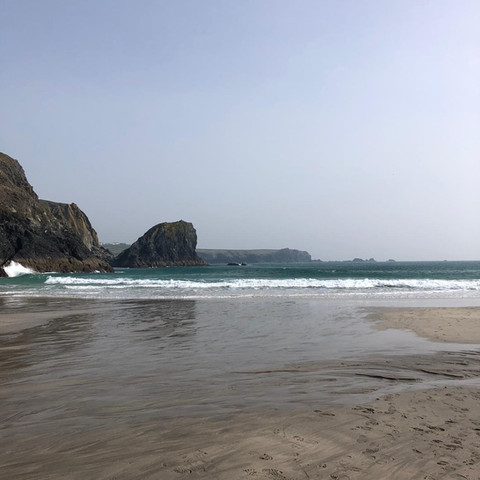South West Coast Path - Mullion Cove to Kynance Cove (The Lizard)
- littlegwendreath
- Apr 1, 2021
- 3 min read
Updated: Jul 4, 2022
Map: OS Explorer: 103
Distance: 4.4 miles/7.1 km
Steepness grade: Moderate
Recommended footwear: Walking boots, or trainers in summer
We set off from Mullion Cove on a very windy spring day and hike up the hill on the coast path towards Predannack Head where the cliffs get even more dramatic and exposed. After the initial fairly steep climb the walk is mainly along the clifftops, but with descents and ascents where valleys meet the coast. Predannack Wollas has been used as a Poldark filming location. The exposed clifftop heathland is punctuated with rocky outcrops and patches of wild flowers making it the ideal backdrop for some of Poldark's full throttle horseback scenes. The cliffs are swathed in thrift, spring squill, campions and orchids along with the more peculiarly named Lizard specialities; fringed rupturewort, hairy greenweed or land quillwort. In the summer the heathland comes into colour with rare pale pink flowers found nowhere else in Britain as they only grow where serpentine rock occurs.
The bedrock of serpentine is tough to farm so is mostly left for cows to graze or nature to reclaim. The National Trust and Natural England are using traditional breeds of pony, sheep and cattle to control the spread of scrub and coarse grasses along the coast path route. Breeds used include the spectacular Highland Cattle, now almost a tourist attraction in their own right. In winter there are often Dartmoor ponies grazing the cliffs. This grazing has also recently encouraged the return of the chough to the Lizard cliffs. With its distinctive high-pitched 'chi-ow' call and its acrobatic tumbling flight displays, the chough is an unmistakable sight.
On our left as we walk southwards is Predannack airfield, mostly used by RNAS Culdrose to practice manoeuvres and we can see occasional glimpses of shells of airplanes and helicopters used by the navy to practice fire drills etc. On our right are views out over Mount's Bay and Mullion Island with the Atlantic swelling against these cliffs all year round.
This is a great spot for wildlife as there is hardly any human habitation alongside the expanses of the airfield and windmill farm nature reserve next door. Birds of prey hunt along the cliffs and in the abandoned fields.
As we enter the last third of our walk we pass by Soapy Cove (or Gew-graze) hidden down a valley on the west coast of the Lizard. At low tide a beautiful golden sand beach is exposed with dramatic rock formations. However, it is almost always empty of visitors due to its location. Here the coast path takes you past the remains of a disused soapstone quarry dating back to the 1700s. This soft rock was used in the porcelain industry until 1819 when by this time china clay was being extracted around St Austell. Between here and Kynance Cove are the remains of Kynance gate settlement left by prehistoric farmers. It now sits surrounded by scrub but still visible in the landscape.
On our descent to Kynance Cove we get a great view of the beach and Asparagus Island next door. The Devil's Letterbox is a cave crack on the north side of Asparagus Island with powerful suction caused by the pull of air from the waves below.
The beach is one of Cornwall’s most beautiful and instantly recognisable with its intriguing rock formations. Towers of serpentine rise out of the near white sand and crystal clear turquoise waters to form one of the most iconic locations in Cornwall. This has been a favourite spot for day-trippers since Victorian times. Many of the caves around Kynance have names from that era like the Ladies' Bathing Pool, the Parlour and the Drawing Room. If you are planning a visit you should aim for low tide as the beach is mainly large rocks when the tide is in. At mid tide you can take a dip in the Mermaid Pool via Queen’s Pool and try a swim to the underwater ‘garden’, a perfect spot for wild swimming! The National Trust manage this area and provide car parking with toilets and a great café next to the beach which is full of eco-friendly features such as solar panels, a turf roof, wool insulation and compost toilets.
It is not hard to see why Poldark's filmmakers were drawn to this location and it appears in the series as Nampara Cove. There are a few notable scenes filmed here including Demelza and Ross landing their fishing boat in rough seas. The clifftops were also used in a the scene involving Ross being marched to jail in Truro in Series 2. However, like the equally stunning Porthcurno, Kynance also suffered from the "Poldark effect" with the cove becoming so overrun during the summer of 2018 that the tourist board took the unprecedented step of asking Poldark fans to stay away.






















Comments